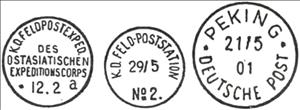Stamp: Value number under a crown in a pearls oval (China - German Post Office (General Issues) 1901)
Value number under a crown in a pearls oval (China - German Post Office (General Issues) 1901)
01 September (China - German Post Office (General Issues) ) within release Boxer riots in Pechili (Northern China), Field Post goes into circulation Stamp Value number under a crown in a pearls oval face value 3 German reichspfennig
| Stamp Value number under a crown in a pearls oval in catalogues | |
|---|---|
| Michel: | Mi: DR-CHI PVaacb |
Stamp is vertical format.
The two PV issues were used by the field post offices and the imperial post offices in the war zone, they must have postmark dates from 9/1/1900 to 8/31/1901, but there are also later cancellations up to 12/31/1902, which mostly owe their existence to collectors' requests. Cancellations are either one of two types of generic Military Post cancellation or a town cancel dated in period (see back picture). Mi: DR 45cb.Also in the issue Boxer riots in Pechili (Northern China), Field Post:
- Stamp - Imperial eagle in a circle face value 25;
- Stamp - Value number under a crown in a pearls oval face value 3;
- Stamp - Value number under a crown in a pearls oval face value 3;
- Stamp - Value number under a crown in a pearls oval face value 3;
- Stamp - Value number under a crown in a pearls oval face value 3;
Stamp Value number under a crown in a pearls oval it reflects the thematic directions:
In British heraldry, a coronet is any crown whose bearer is less than sovereign or royal in rank, irrespective of the crown's appearance. In other languages, this distinction is not made, and usually the same word for crown is used irrespective of rank (German: Krone, Dutch: Kroon, Swedish: Krona, French: Couronne, etc.) In this use, the English coronet is a purely technical term for all heraldic images of crowns not used by a sovereign, and implies nothing about the actual shape of the crown depicted. A Coronet is another type of crown, but is reserved for the lower ranks of nobility like Marquesses and Marchionesses, Earls and Countesses, Barons and Baronesses, and some Lords and Ladies. The specific design and attributes of the crown or coronet signifies the hierarchy and ranking of its owner.
A number is a mathematical object used to count, measure, and label. The most basic examples are the natural numbers 1, 2, 3, 4, and so forth. Numbers can be represented in language with number words. More universally, individual numbers can be represented by symbols, called numerals; for example, "5" is a numeral that represents the number five. As only a relatively small number of symbols can be memorized, basic numerals are commonly organized in a numeral system, which is an organized way to represent any number. The most common numeral system is the Hindu–Arabic numeral system, which allows for the representation of any non-negative integer using a combination of ten fundamental numeric symbols, called digits. In addition to their use in counting and measuring, numerals are often used for labels (as with telephone numbers), for ordering (as with serial numbers), and for codes (as with ISBNs). In common usage, a numeral is not clearly distinguished from the number that it represents.


